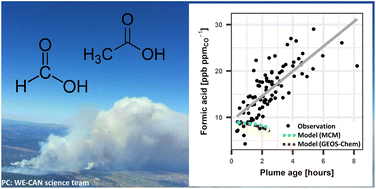Environ. Sci.: Atmos., 2023, Advance Article
DOI: 10.1039/D3EA00098B, Paper
DOI: 10.1039/D3EA00098B, Paper
 Open Access
Open Access This article is licensed under a Creative Commons Attribution-NonCommercial 3.0 Unported Licence.
This article is licensed under a Creative Commons Attribution-NonCommercial 3.0 Unported Licence.Wade Permar, Catherine Wielgasz, Lixu Jin, Xin Chen, Matthew M. Coggon, Lauren A. Garofalo, Georgios I. Gkatzelis, Damien Ketcherside, Dylan B. Millet, Brett B. Palm, Qiaoyun Peng, Michael A. Robinson, Joel A. Thornton, Patrick Veres, Carsten Warneke, Robert J. Yokelson, Emily V. Fischer, Lu Hu
Rapid production of formic acid in biomass burning smoke is not captured by the Master Chemical Mechanism (MCM) nor simplified GEOS-Chem chemistry, likely due to missing secondary chemical production.
To cite this article before page numbers are assigned, use the DOI form of citation above.
The content of this RSS Feed (c) The Royal Society of Chemistry
Rapid production of formic acid in biomass burning smoke is not captured by the Master Chemical Mechanism (MCM) nor simplified GEOS-Chem chemistry, likely due to missing secondary chemical production.
To cite this article before page numbers are assigned, use the DOI form of citation above.
The content of this RSS Feed (c) The Royal Society of Chemistry

